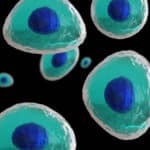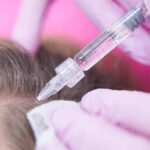Modern trichology and regenerative medicine offer increasingly effective methods of supporting hair growth and treating various types of alopecia. Among the most popular and valued therapies are PRP, or platelet-rich plasma, and the increasingly used exosomes. Although both methods are based on biological regeneration and utilize the body’s natural mechanisms, they differ in their mechanism of action and range of effectiveness. At Piotr Turkowski’s Clinic, we successfully use both forms of therapy – tailoring them individually to each patient’s needs. It is worth taking a closer look and comparing which one may bring better results in specific cases.
What is PRP therapy and what are exosomes?
PRP therapy (Platelet-Rich Plasma) is based on the use of plasma rich in platelets, which is obtained from the patient’s own blood through centrifugation. Platelets contain natural growth factors that support tissue regeneration, stimulate microcirculation, and activate stem cells located within the hair follicles. The PRP procedure is well tolerated because it uses autologous material – originating from the patient’s own body.
Platelet-Rich Plasma (PRP) for hair at PT CLINIC
Exosomes, on the other hand, are nanoparticles secreted by cells that serve a communicative function in the body. They are rich in growth factors, enzymes, proteins, and microRNA, which influence the activity of other cells – including scalp and hair follicle cells. Exosomes used in therapy usually come from mesenchymal stem cells and are available as a ready-to-use preparation administered directly into the scalp in a manner similar to PRP.
Exosome therapy for hair at PT CLINIC
How do exosomes and PRP work on hair follicles?
Both PRP and exosomes share a common goal – to stimulate hair follicles to function, improve microcirculation, and restore proper conditions for hair growth. PRP mainly works by locally increasing the concentration of growth factors, which stimulate skin cells to regenerate and improve blood supply. The effect is reduced hair loss, improved structure, greater density, and the appearance of new hair in thinning areas.
Exosomes, however, act much more broadly – not only stimulating blood vessels and supporting follicle nourishment, but also directly affecting the activation of dermal papilla cells, regulating inflammation, and restoring the proper hair growth cycle. Importantly, exosomes can act even on dormant follicles, which in the case of PRP therapy do not always respond strongly enough. For this reason, they are increasingly chosen as a therapy for patients with advanced alopecia.
Effectiveness of both therapies – what do experience and studies say?
PRP therapy already has a long history of use in dermatology and aesthetic medicine. In many cases, especially in the early stages of androgenetic alopecia, it brings very good results – provided that sessions are performed regularly and a healthy lifestyle is maintained. Results usually appear after a few treatments and include reduced hair loss and improved hair quality.
Exosomes, however, represent a newer and more advanced form of regenerative therapy. Although not every body responds the same way, clinical observations indicate that exosomes often provide faster and more spectacular results – especially in people who did not respond well to PRP or struggle with chronic, hard-to-stop hair loss. Laboratory studies have shown that exosomes exhibit higher regenerative activity and better support the growth of blood vessels, which directly translates into improved follicle condition.
Tolerance – who is PRP for and who are exosomes for?
Both PRP and exosomes are proven therapies, but their tolerance profile differs depending on the source of the material. PRP uses the patient’s own blood, which virtually eliminates the risk of allergic reactions or rejection. It is a good option for people who prefer therapies based on their own body resources and do not want to use external preparations.
Exosomes are derived from stem cells and undergo purification and standardization processes. Although they do not come from the patient, they are biologically neutral and very well tolerated – they contain no cellular DNA, meaning they do not trigger an immune response. In practice, this means that exosomes can be used in people who do not qualify for PRP therapy (e.g., due to poor blood quality), as well as in those who did not achieve sufficient results after other treatments.
Exosomes or PRP – which to choose?
The choice of the appropriate therapy should always be preceded by a thorough consultation and trichological diagnosis. At Piotr Turkowski’s Clinic, we analyze the individual needs of each patient – their type of alopecia, scalp condition, previous treatment methods, and expectations regarding results. In younger individuals with early androgenetic alopecia, PRP often works very well. However, in patients with weakened follicle condition, chronic alopecia, or after a hair transplant – exosomes may be a more comprehensive solution.
Comparison of PRP vs. Exosomes – effectiveness and tolerance
| Criterion | PRP (Platelet-Rich Plasma) | Exosomes |
|---|---|---|
| Source | Patient’s own blood | Stem cells (MSC) |
| Content | Platelets, growth factors | Proteins, RNA, growth factors, enzymes |
| Action | Regeneration, stimulation of circulation | Regeneration, follicle activation, immunomodulatory effect |
| Results | Visible after 2–3 sessions | Often faster and deeper results |
| Tolerance | Very good, autologous material | High, no DNA, no allergy risk |
| Use | Androgenetic alopecia, early-stage hair loss | Chronic alopecia, resistant cases |
| Cost | Lower | Higher (advanced technology) |
In practice, both methods are increasingly combined within a synergistic therapy – PRP may be used as preparation before exosome treatments or as support between sessions to maintain stimulation effects. This approach achieves a synergistic effect, improving hair quality, accelerating scalp regeneration, and enhancing the long-term effectiveness of therapy.







